|
|
Ingredients:
|
| For the Syrup: |
|
-
3 cups water |
|
- 2 cups fresh orange juice |
|
- 1 tbsp fresh lemon juice |
|
- 2 cups granulated sugar |
|
- 1 cinnamon stick |
| - 1 piece fresh lemon peel |
| - 1/2 tbsp cloves |
|
| For the Halva: |
| - 1 cup olive oil |
|
| - 2 1/4 cups fine semolina |
| - 1/4/ cup sliced almonds, finely chopped |
| 1/4 cup pine nuts |
|
| To Serve: |
|
- 1 tsp cinnamon
|
|
|
|
Preparation:
To make the Syrup: place the water, orange juice, lemon juice and sugar in a saucepan and bring to a boil. Add the cinnamon stick, lemon peel and cloves. Simmer over low heat for 10 minutes. Allow to cool, then remove the cinnamon stick, lemon peel and cloves by passing through a fine sieve.
To make the Halva: heat the olive oil in a large saucepan over meduim heat. Add the semolina, almonds and pine nuts. Cook the mixture over a low heat, stirring constantly, until the mixture begins to turn a golden color or for about 15 to 20 minutes, being careful not to burn the mixture. Remove from the heat.
Carefully pour the syrup over the semolina mixture, stirring with wooden spoon. Cover with a kitchen cloth and leave for 10 minutes to let the mixture absorb the syrup. Spoon the mixture into individual bowls and allow to cool. Before serving, sprinkle each bowl with cinnamon.
(Serves 4)
|
|
Excerpts from:
"Modern Greek: 170 Contemporary Recipes from the Mediterranean " |
|
|
Watch Your Manners In Greece |
|
Hospitality |
|
Continued from September's issue...
- Unfortunately some things in life are not passed
on through the generations: What today passes as
hospitality barely resembles all that was entailed
by that word in Ancient Greek households.
Selfishness, the tendency towards privacy and
absorption in personal comfort have stopped people
from keeping an open house for foreigners and
strangers. Weekend breaks and "holidays in the
countryside" are the only forms of hospitality left.
- For many people, hospitality ends where racism
begins. We should be more hospitable towards
immigrants in our country, bearing in mind that we
ourselves have been in a similar position to these
poor foreigners - thousands of Greeks emigrated to
Germany 40 years ago and to the United States of
America 80 years ago.
- Many ancient rules of hospitality do still apply
today, however. All guests are considered honored
members of the family. They have the best seats at
the dinner table, they are offered the best room to
sleep in, and the hosts are glad to fulfill any
request they may have.
- We shouldn't invite people whom we have just met
for a long stay. A weekend is more than sufficient.
- The length of a guest's stay, including dates of
arrival and departure, should be clearly
pre-arranged.
- When arriving at somebody's house as a guest, we
should always offer a gift. After departure, we
should send flowers to our hostess.
- When staying at somebody's country house, we
should keep the family's schedule, especially as
regards meal and bed times.
- Guests should not make overseas calls or call
mobile phones from the house's landline.
- When we invite friends to stay, we should not
subject them to a military regimen nor should we
organise every second of our guest's stay. Good
hosts are those who offer a flexible, lenient
schedule for their guests.
- If we have challenged our guest to a tavli, chess,
or tennis match, good manners do not oblige us to
lose in order to prove that we are good hosts. We
should play fair and just, so that both parties can
enjoy the game.
- If, however, our co-player is a child or an
elderly person, and the price is not too high for us
topay, we may - if we wish - lose so as to cheer
them up.
- When leaving the house, we make sure we have all
our belongings with us. We do not wish to leave
anything behind except good memories.
- We keep our mouths shut as far as the host
family's secrets are concerned.
- We should send our host a "thank you" note. This
is much better than making a phone call.
12 tips that make a good guest:
1. Guests should not "drop anchor" as soon as they
arrive. A common Greek saying says, "A fish and a
guest both stink after three days." A visitor must
depart leaving his hosts with the desire to invite
him again soon.
2. He should invite his hosts for dinner at a
restaurant during his stay.
3. He should not be demanding and idiosyncratic,
asking, for example, for a caviar and champagne
breakfast.
4. He should not show that he is bored.
5. He should try and make himself useful, helping
out with household chores, food shopping etc.
6. He should not take sides if his hosts are having
a row.
7. He should let them "breathe" from time to time.
Sometimes he should go out alone to visit a museum
or an exhibition, for example.
8. He should not become over-familiar with family
members. For example, it is unacceptable for him to
call an elderly woman "granma."
9. He should not make negative comments about the
house's tenants.
10. He should take care of the house's furniture and
shouldn't swap things around at will, as if they
were his own.
11. He should not accept invitations to other
people's houses while he is a guest, unless his host
is also invited.
12. He should think twice before bringing over a
"one night stand" he met at a club.
Excerpt from "Watch Your Manners In Greece" by
Christos K. Zampounis
|
|
|
|
Special Feature:
Greek Mountain Tea
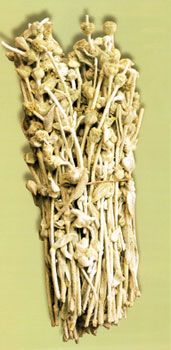 Greek
mountain tea can be found in almost every
Greek household. When the weather
turns cooler and the first signs of an
impending cold or cough manifest themselves,
when the limbs aches, or when you just feel
under the weather, a tea made from the dried
stalks of Sideritis cretica has
beneficial and curative effect. The
twigs are broken into pieces, which are then
put into a pan of boiling water. They
are left over a low heat for at least five
minutes to infuse rather than to simmer, and
then strained straight into cups. The
addition of cinnamon sticks enhances the
flavor still further. The Greek ironwort is a medium-high shrub that has an
upright form, with opposing, wooly leaves
growing on straight, relatively
non-branching stalks. The plant
manages to survive on sites with hot, dry
summers. Its small, yellow flowers are
rather unobtrusive. The botanical name
Sideritis, derived from the Greek
word sideros, meaning iron,
indicates this plant's areas of application
in ancient medicine. It was used
externally for its anti-inflammatory and
astringent properties in the case of "wounds
from iron struck into limbs," and internally
for its ability to strengthen the body's
powers of resistance. When the
Venetians discovered the tea, they called it
malotira because it "draws out the
illness." Greek
mountain tea can be found in almost every
Greek household. When the weather
turns cooler and the first signs of an
impending cold or cough manifest themselves,
when the limbs aches, or when you just feel
under the weather, a tea made from the dried
stalks of Sideritis cretica has
beneficial and curative effect. The
twigs are broken into pieces, which are then
put into a pan of boiling water. They
are left over a low heat for at least five
minutes to infuse rather than to simmer, and
then strained straight into cups. The
addition of cinnamon sticks enhances the
flavor still further. The Greek ironwort is a medium-high shrub that has an
upright form, with opposing, wooly leaves
growing on straight, relatively
non-branching stalks. The plant
manages to survive on sites with hot, dry
summers. Its small, yellow flowers are
rather unobtrusive. The botanical name
Sideritis, derived from the Greek
word sideros, meaning iron,
indicates this plant's areas of application
in ancient medicine. It was used
externally for its anti-inflammatory and
astringent properties in the case of "wounds
from iron struck into limbs," and internally
for its ability to strengthen the body's
powers of resistance. When the
Venetians discovered the tea, they called it
malotira because it "draws out the
illness."
This special variety of ironwort, Sideritis
cretica, thrives in the highlands of Greece
and is considered particularly effective and
aromatic among mountain tea connoisseurs
Excerpt from:
"Culinaria
Greece" by Marianthi Milona
|
|
|
Don't Forget to Pick Up Your Greek
Christmas Ornaments!!
Order your Greek Christmas ornaments in
advance to
ensure product availability.
|
|
|
What's
New!!! |
|
Featured New
Additions |
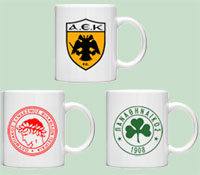 |
Greek Soccer Team Mug Cups
Display your Greek team's colors with pride! A mug
with the logo of your favorite Greek soccer team! A
perfect gift for any Greek soccer fan. |
 |
| |
|
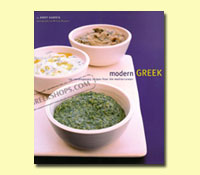 |
Modern Greek : 170 Contemporary Recipes from the
Mediterranean
Delicious and Healthful, redolent of the flavors of
the Mediterranean, and perfect for the way we like
to eat today - it's no wonder that Greek food is so
beloved. In homes and at restaurant tables around
the world, its glorious heritage is being enjoyed
more and more, with its classic flavors celebrated
in a host of new and mouthwatering ways. |
|
|
 |
| |
|
 |
From Tapas to Meze by Joanne Weir
Life at the table in the sun-drenched communitites
surrounding the Mediterranean has as much to do with
feeding the heart and soul as the stomach. Peek into
a crowded tapas bar of wander by a rustic outdoor
taverna and you'll find people fathered together in
lively conversation, sharing steaming bowls of
pasta, tiny deep-fried fish, roasted sweet
vegetables, and savory pizzas. |
|
|
 |
|
|
|
Music & DVDs |
|
|
|
Books |
|
|
|
T-shirts
& Sweatshirts |
|
|
|
Women's Apparel |
|
|
|
Children's
T-shirts & Sweatshirts |
|
|
|
More
Additions! |
|
|
|
Featured Destination: Tenos
|
|
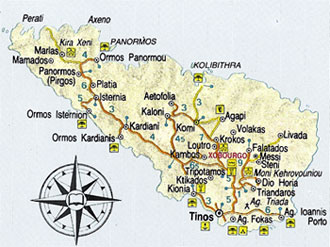 GEOGRAPHY.
Tenos, the Holy island of the Virgin, lies between
Andros (700 m.), Mykonos (8 nautical miles) and
northeast of Syros (13 nautical miles). It is the fourth
largest of the Cyclades, after Naxos, Andros and Paros,
covering an area of 194 sq. km., with 106 km. of coast
and 85 nautical miles from Piraeus. Its population is
7,730. There are daily car and passenger ferries from
Piraeus and Rafina (62 nautical miles), as well as links
with Andros, Mykonos, Paros, los and Santorini. The
island's capital and harbor, Tenos, is a convenient
centre for visiting the other villages on the island,
large and small. Tenos is essentially mountainous
(highest peak Tsikinas, 713 m. a.s.l.) with a few small,
fertile valleys. Its coast, mainly steep in the east,
follows the configuration of the land, forming small
bays, the largest and most sheltered of which is the
gulf of Panormos on its northeast side. Tenos has its
own, distinctive Cycladic charm: lush, verdant
vegetation, small villages with snow-white houses,
ornate dovecotes and numerous tiny chapels. There is
limited touristic development and Tenos is just right
for quiet holidays. GEOGRAPHY.
Tenos, the Holy island of the Virgin, lies between
Andros (700 m.), Mykonos (8 nautical miles) and
northeast of Syros (13 nautical miles). It is the fourth
largest of the Cyclades, after Naxos, Andros and Paros,
covering an area of 194 sq. km., with 106 km. of coast
and 85 nautical miles from Piraeus. Its population is
7,730. There are daily car and passenger ferries from
Piraeus and Rafina (62 nautical miles), as well as links
with Andros, Mykonos, Paros, los and Santorini. The
island's capital and harbor, Tenos, is a convenient
centre for visiting the other villages on the island,
large and small. Tenos is essentially mountainous
(highest peak Tsikinas, 713 m. a.s.l.) with a few small,
fertile valleys. Its coast, mainly steep in the east,
follows the configuration of the land, forming small
bays, the largest and most sheltered of which is the
gulf of Panormos on its northeast side. Tenos has its
own, distinctive Cycladic charm: lush, verdant
vegetation, small villages with snow-white houses,
ornate dovecotes and numerous tiny chapels. There is
limited touristic development and Tenos is just right
for quiet holidays.
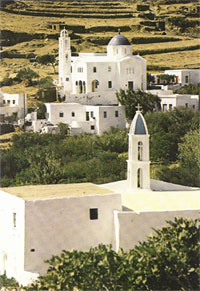 HISTORY.
In antiquity the island was called Ophiousa. We have
very little information about Tenos in prehistoric times
though excavations (Vryokastro) have shown that it was
inhabited in the Bronze Age, during the period of the
Cycladic civilization. Throughout antiquity, as indeed
today, it was famed for its marble and there is a
tradition of stone-carving. In the 8th and 7th century
BC it was under the domination of Eretria. During the
Persian Wars it was captured by the Medes, liberated
after the battle of Marathon and took part in the naval
battle of Salamis. It achieved its zenith in the 3rd
century BC, while in the 2nd it was a naval station of
the Rhodians. Tenos was taken by the Romans in 88 BC and
decimated by Mithridates. During the Byzantine period it
faded into obscurity and with the Fall of Constantinople
to the Franks it, like the rest of the Cyclades, came
under the control of Venice, which ceded it to the Ghisi
family. The Venetians built a fortress on the pinnacle
of a steep cliff on its south coast. Within its walls
the Venetian nobles resided, while outside, at Exoburgo,
the peasants dwelt. During the Venetian occupation many
of the islanders adopted the Catholic faith. In 1538 it
was pillaged by Barbarossa but did not fall to the Turks
until 1715. Between 1770 and 1774 it was under Orloff.
Many Greek refugees from Psara and Chios fled to Tenos
during the Revolution of 1821. In 1822 the miraculous
icon of the Virgin was discovered. It was in the harbor
of Tenos that the Greek warship "Elli" was torpedoed by
the Italians in 1940. HISTORY.
In antiquity the island was called Ophiousa. We have
very little information about Tenos in prehistoric times
though excavations (Vryokastro) have shown that it was
inhabited in the Bronze Age, during the period of the
Cycladic civilization. Throughout antiquity, as indeed
today, it was famed for its marble and there is a
tradition of stone-carving. In the 8th and 7th century
BC it was under the domination of Eretria. During the
Persian Wars it was captured by the Medes, liberated
after the battle of Marathon and took part in the naval
battle of Salamis. It achieved its zenith in the 3rd
century BC, while in the 2nd it was a naval station of
the Rhodians. Tenos was taken by the Romans in 88 BC and
decimated by Mithridates. During the Byzantine period it
faded into obscurity and with the Fall of Constantinople
to the Franks it, like the rest of the Cyclades, came
under the control of Venice, which ceded it to the Ghisi
family. The Venetians built a fortress on the pinnacle
of a steep cliff on its south coast. Within its walls
the Venetian nobles resided, while outside, at Exoburgo,
the peasants dwelt. During the Venetian occupation many
of the islanders adopted the Catholic faith. In 1538 it
was pillaged by Barbarossa but did not fall to the Turks
until 1715. Between 1770 and 1774 it was under Orloff.
Many Greek refugees from Psara and Chios fled to Tenos
during the Revolution of 1821. In 1822 the miraculous
icon of the Virgin was discovered. It was in the harbor
of Tenos that the Greek warship "Elli" was torpedoed by
the Italians in 1940.
SIGHTS-MONUMENTS. Tenos, the island's capital,
stands on its south side. It developed after the
Venetians' retreat in 1715 and is a typical island town
with whitewashed houses and narrow streets. The most
important monument there, and indeed on the entire
island, is the church of the Virgin, built in 1823
following the discovery of her icon. It is an imposing
edifice of white marble and has several ancillary
buildings. The Museum of Tenian Artists and Modern Greek
Painters is well worth a visit, with works by
contemporary Greek artists, while in the Art Gallery
there is a collection of reproductions of works by
Renaissance painters. There is a rich library in the
monastery and sacristy with vestments and ecclesiastical
plate. Exhibited in the Archaeological Museum are finds
from sites all over the island. East of the town of
Tenos is the monastery of the Holy Trinity (1610) where
there is a small collection of local folk art, and even
further east is the Venetian harbor of Aghios loannis
(Ai Yannis sto Porto). In the environs of the town and
in the villages there is a proliferation of dovecotes;
elaborately embellished, they constitute one of the
distinctive features of the island. 5 km. northeast of
Tenos is Triantaros, a picturesque village with a church
of the Taxiarchs. Slightly to the north is Dyo Choria
(two villages) built on a richly wooded hillside. From
here one has a view of the nearby convent of
Kechrovouniou, dedicated to the Dormition of the Virgin,
where-there is the cell of Hosia Pelagia, the nun who
dreamt of the finding of the icon of the Virgin
Evangelistria. There is a little chapel consecrated to
her memory, as well as several other smaller churches
and handicraft workshops. 2 km. northeast are the
villages of Mesi and Steni. In the immediate vicinity is
the monastery of St. Anthony with its magnificent
Byzantine iconostasis. From Steni one can proceed to the
villages of Myrsini and Falatados. Remains of the
Venetian castle and medieval town are preserved 3 km.
from Steni, at Xobourgo. In addition to the Venetian
ramparts and ruined castle, some ancient Greek remains
can be discerned (8th/7th century BC) in the area
between Xobourgo and Xynara. The Ursuline convent at
Loutra was renowned for its school. The next village,
Komi, is one of the largest on Tenos and has many
authentic Tenian houses in good condition. A minor road
leads to Kolymbithra, one of the most delightful beaches
on the island's east side. From Xobourgo one can also
visit Kampos, and further northwards one passes through
the villages of Tarabados with its ornate dovecotes and
Kardiani with its quaint houses and little churches.
Immediately after Kardiani is the village of Ysternia,
where many modern artists live, and northwest of here is
one of the oldest churches on Tenos, that of St.
Athanasios (1453) and the monastery of the Virgin
Katapoliani (1786). The largest and perhaps loveliest
village on the island is Pyrgos, (Panormos) with a long
tradition in stone-carving and painting, birthplace of
many Greek artists. There is a museum of works by
Yannoulis Chalepas in his family home and there are
ateliers of sculpting, painting and wood-carving. The
houses in Pyrgos are characterized by their ornate
exteriors particularly of carved marble. There are also
elaborately decorated fountains and several interesting
churches, of St. Eleousa and of the Presentation of the
Virgin. About 3 km. distant from Pyrgos is the
picturesque bay of Panormos which is quickly growing
into a holiday resort. 5km. northwest of Pyrgos, at
Marlas is the nowadays abandoned monastery of Hosia
Xeni.
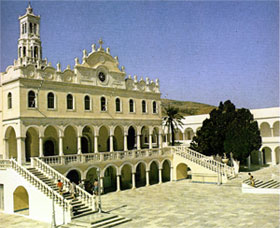 |
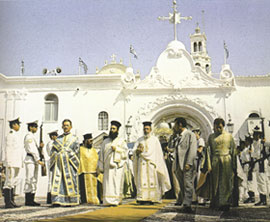 |
Northwest
of the town of Tenos is Kionia (3 km.), in an attractive
setting with a unique view of the open sea. Excavations
have brought to light ruins of the 3rd century BC
temple, initially for the worship of Poseidon and later
of Amphitrite, one of the major cult centers in the
Cyclades in antiquity.
Several of Tenos' shores are ideal for swimming and
fishing, as well as sea sports. The beaches at Aghios
Phokas, Kionia, Ai Yannis sto Porto, Kolymbithra, the
bay of Kardiani and Ysternia are particularly beautiful,
and further north is the bay of Panormos. All are
accessible by car. One can shoot birds and small game in
the island's mountainous hinterland. For those with a
boat there are plenty of beaches to explore. Refueling
stations in the harbor. |
|
|
|
Travel
& Museum
Guides for your trip in the area |

Around Greece in 80 Stays by Jacoline Vinke |

Alistair Sawday's Special Places to Stay - Greece |

Cyclades : Discovering the Greek Islands of the Aegean |

Athens - History, Momuments, Museums (in English) |

National Museum - Illustrated Guide to the Museum (in
English) |
| |
|
Saints'
Name days in October |
|
Monday |
Tuesday |
Wednesday |
Thursday |
Friday |
Saturday |
Sunday |
|
|
|
|
|
|
|
1
Ananiou / Pomanou Melodou |
2
Kuprianou / Ioustiounis |
3
Dionisiou Aeropagitou |
4
Ierotheou |
5
Xaritinis |
6
Thoma |
7
Poluxroniou |
8
Iakovou |
|
9
Eulampiou |
10 |
11 |
12 |
13 |
14 |
15
Loukianou |
|
16 |
17 |
18
Louka |
19
Kleopatras |
20
Artemiou / Gerasimou Kefallhnias |
21
Sokratous |
22 |
23
Iakovou
|
24
Sevastianis
|
25
|
26
Dimitriou Myrovlitou |
27
Nestoros |
28
Agias Skepis
|
29 |
30
Zinoviou
|
31 |
|
|
|
|
|
|
|
Icons
depicting the celebrated Saint, make great gifts for
namedays.
Shop among our great collection of icons at our
store. Also available, namedays, birthday, holiday, and
special occasion greeting cards.
|
|
Share
With Others!!!! |
Let your family and friends share the savings by
forwarding them this email.
|
|
Suggestions
& Comments |
Dear Greekshops.com customer,
Thank you for contributing to our effort to bring
unique and hard to find Greek products to your home. We
value your opinion, so please let us know if you have
any concerns, suggestions, comments that will improve
and help us grow. Send us your feedback at:
[email protected]
|
|
Subscription
Information |
|
Missed an issue of our
newsletter? Now you can access past newsletters by
visiting
http://www.greekshops.com/newsletters_archive
To
unsubscribe from our mailing list,
click here
|
|
|
|

